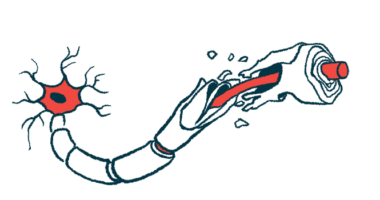Repairs done by Schwann cells help limit nerve damage in CMT: Study
Therapies activating certain pathways in the cells could be helpful in treatment

In Charcot-Marie-Tooth disease (CMT), a type of support cell called Schwann cells help to repair nerve injury to limit the severity of the disease, a new study suggests.
The finding suggests that therapies aiming to activate certain pathways in these cells may be beneficial in CMT and other peripheral nervous system disorders.
“Harnessing Schwann cell repair programs has great potential in treating chronic diseases,” Samuel Pfaff, PhD, co-author of the study at the Salk Institute for Biological Studies, said in a university news story. “It’s possible that with targeted therapeutics, we can prompt more Schwann cells to repair peripheral nerve damage and push those repairs to completion in chronic cases.
“Furthermore, now that we have a better grasp on the repair mechanisms, we can see if it’s possible to initiate repairs in the brain stem and spinal cord, too.”
The study, “Mitf is a Schwann cell sensor of axonal integrity that drives nerve repair,” was published in Cell Reports.
Peripheral nerves can repair damage, which Schwann cells play key role in
CMT is a genetic disorder characterized by peripheral neuropathy — damage to the nerves that run throughout the body, outside of the brain and spinal cord. Schwann cells are support cells in the peripheral nervous system that are responsible for making myelin, a fatty substance that wraps around nerve fibers and helps them send electric signals (a bit like rubber insulation around a metal wire).
Unlike their counterparts in the brain, peripheral nerves are usually pretty good at repairing damage if they get injured. Schwann cells are known to play a key role in this repair process: when an axon (nerve fiber) is damaged, Schwann cells rapidly change their activity to help fix the issue.
It’s been well established that this happens when nerves are physically injured, such as from being cut or crushed. But in this study, scientists working with mouse models found Schwann cells become similarly activated in CMT, where peripheral nerve damage is caused by genetic mutations.
Results showed that, in both injury and genetic disease, Schwann cells rely on a protein called Mitf to go into repair mode.
“Previously, there have not been clear markers for repair [Schwann] cells. This study reveals genetic signatures for this cell population that are shared between injury and disease,” the researchers wrote.
Mitf is a transcription factor — a protein that helps cells to control the activity of specific genes. The researchers found that, when peripheral nerves are injured, Mitf becomes activated in Schwann cells to turn on a bunch of genes that can help promote nerve repair and are implicated in processes such as cell migration.
“Taken together, the expression of this core gene set represents a beneficial … response for promoting injury repair and offsetting disease progression,” the team wrote.
“We wanted to know what mechanisms control damage response in peripheral nerves under varying conditions—like acute trauma, genetic disorders, or degenerative diseases,” Pfaff said. “We found that Schwann cells, which are special cells in nerves that protect and support neurons’ axons, enter their repair state because of a pathway mediated by the protein Mitf.”
Mice lacking the Mitf protein had impaired nerve regeneration and repair.
“Going into this project, I thought that when you have a genetic nerve degeneration disorder, cells are dying and recovery isn’t possible. But our findings show that there are gene programs turned on by Mitf that repair some of the damage done in those chronic disease scenarios, and when you turn those programs off, disease symptoms get worse,” said Lydia Daboussi, PhD, study first author and professor at the University of California, Los Angeles.







